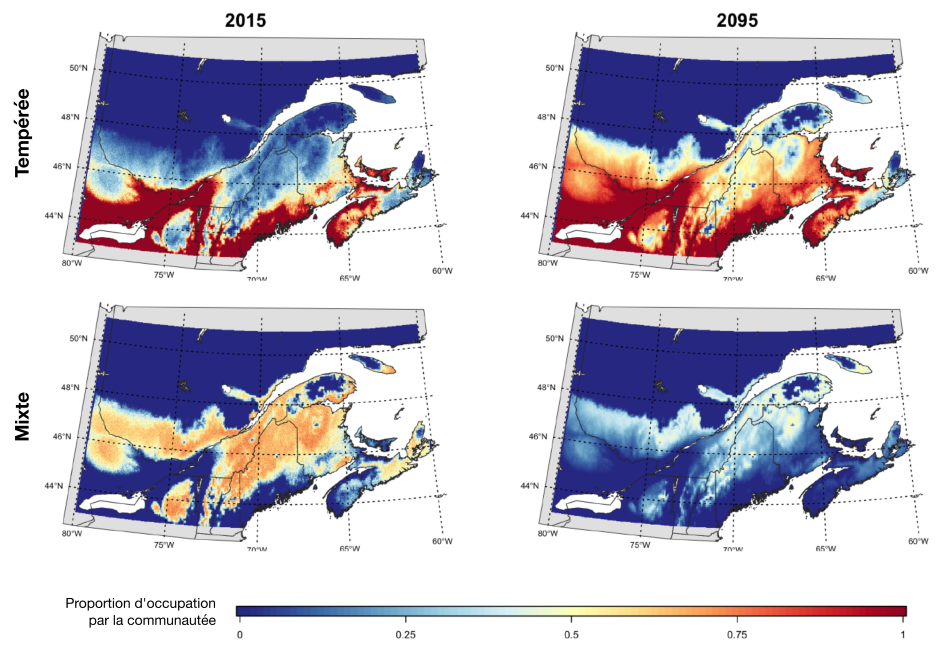Quantifying and Mapping the Impacts of Climate Change on Forest Productivity in Eastern Canada
The results of preliminary simulations and theory support the idea that forest management could accelerate the response of forest stands to climate change. Opening the forest canopy accelerates succession by modifying competition interactions within the stand.
Project details
Principal(s) investigator(s)

Context
The tools currently available for modeling how forests respond to climate change are limited by their failure to integrate fundamental ecological processes.
On the one hand, in order to estimate future forest productivity, forest managers use parametric growth curves for different regions. On the other hand, biodiversity managers use species distribution models based on the current relationship between distribution and climate. Neither of these models is optimal pour projecting future forest yields because they fail to take into account the complex interaction between forest management, tree migration and interspecific competition.
The resulting projections are unrealistic and of limited use to forestry managers. This project seeks to develop an integrated suite of tools to quantify the productivity of forests in boreal-temperate transition zones, where the greatest changes are likely to occur.
Objective(s)
-
Develop a series of forest dynamics models to better understand the future distribution of the temperate forest and its productivity at the end of the century;
-
Assess the impacts of climate change on the management strategies adopted for this ecosystem.
Methodology
-
Develop competition models for short-term projections (10-25 years) of the impacts of climate change on productivity;
-
Develop models simulating forest dynamics in order to predict future changes in species distribution and long-term productivity (100-200 years);
-
Develop a general model for productivity of the forest ecosystem under climate change;
-
Develop practical applications of these models and innovative forest management strategies in order to reduce the expected impacts of climate change on the productivity of mixed temperate forest.
Results
A series of simulation models at the individual, stand and forest landscape levels were developed to better understand the combined impacts of climate change and forest management on temperate forest migration. A new approach to species distribution modelling was created based on tree dynamics and taking into account competition and dispersal. The project provided a better understanding of uncertainty in the productivity projections for different species following climate change. The most significant source of uncertainty arises not from the quality of the ecological models (which proved to be excellent), but rather from uncertainty in the climate change scenarios.
Mapping of the areas the most sensitive to climate change showed that the capacity of forests to respond to climate change is minimal where the greatest change is likely to occur, namely at the current limit of the temperate forest. In the pessimistic RCP 8.5 scenario, forest dynamics projections show that temperate forest will not migrate northward over the next 100 years, despite a shift in favourable climate conditions of several hundred kilometres (Fig. 1).

Figure 1. Projected distribution of temperate and mixed forest under scenario RCP 8.5. Note the lack of northern migration of temperate forest and the decreased presence of mixed forest.
More precisely, the following four results are worth mentioning, due to their relevance to the fields of community ecology, biogeography and forest ecology:
-
Tree species range is determined by regional colonization and extinction processes, not by local demographics;
-
The capacity of forest ecosystems to respond to climate change is minimal in the transition zone between biomes, where the greatest change is likely to occur;
-
Multi-scale integration is necessary in order to reduce the propagation of uncertainty in forest dynamics predictions;
-
Biotic interactions can have a major effect on migration speed; it is therefore more important to understand the transition dynamics following a change in climate than the state of balance.
Finally, perceptions of forestry issues in Canada were characterized by means of a survey of stakeholders across the country. The results revealed a pressing need for a strategic analysis of the combined impacts of forest management and climate change. The survey also showed that, even though forestry stakeholders are aware of climate change, they do not have knowledge of or access to the tools needed for adaptation.
Benefits for adaptation
The results of preliminary simulations and theory support the idea that forest management could accelerate the response of forest stands to climate change. Opening the forest canopy accelerates succession by modifying competition interactions within the stand.
Judicious planning of harvesting activities would be a means of adapting to climate change that is consistent with the concerns of the forestry industry, given that forest ecosystems have a low likelihood of changing composition at the southern limit of the boreal coniferous forest in the absence of natural disturbances or harvesting.
Scientific publications
Funding


Other participants
-
Cary Institute of Ecosystem Studies
-
CNRS
-
Conférence régionale des élus Bas-St-Laurent
-
Conservation de la nature Canada
-
Domtar
-
Ministère des Ressources naturelles de l’Ontario
-
Ministère des Forêts, de la Faune et des Parcs
-
Produits Forestiers Résolu
-
Service Canadien des Forêts, Ressources Naturelles Canada
-
Université du Québec à Montréal
-
Université du Québec en Abitibi-Témiscamingue
-
Université du Québec en Outaouais
-
Washington State University